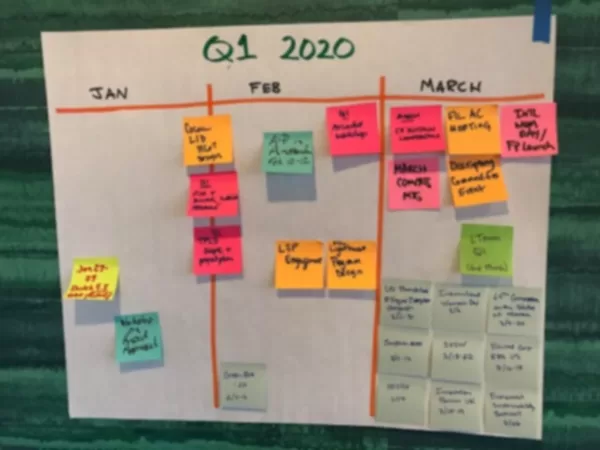Team Calendaring Activity
If you are facilitating a team annual meeting, it might be useful to do a team calendaring activity. In this exercise, key events, dates, and targets are collected in calendars on the wall. This “year-at-a-glance” allows the team the opportunity to identify times of the year that will be particularly busy or slow for individuals and/or the team as a whole.
Using this information, the team might:
- Move events or targets to a more ideal time.
- Plan team events at times convenient for everyone.
- Anticipate busy periods and plan ahead.
- Look for opportunities to support and collaborate.
Instructions:
- Pre-populate chart paper with labels for each month of the year. (I usually do one quarter per page, so it all fits on one wall.)
- Identify and list out the types of events that should and should not be captured. It’s important to scope this so you have the right amount of useful information (and not more).
- Give each person on the team a unique color of sticky notes and a dark marker.
- Ask each person to write down their event, target, etc. on their sticky notes and post them in the correct month.
- Consider pre-populating sticky notes for the organization, industry, or team events that affect everyone. (This might include conferences, team meetings, holidays, etc.)
- Once they are all posted, go month by month and read each event. Then, look at each quarter. Finally examine the year as a whole. Some questions you might ask the team are:
- What do you notice about our calendar that concerns you?
- Is there anything missing that we need to add?
- What, if anything, might we move, change, or cancel?
- What are the time periods where we need to be cautious?

Additional variations:
- Preprint calendars on a large poster paper with known dates.
- Use dot stickers to highlight who on the team is engaged in the events.
- Divide the chart into sections. For example, put all the events that effect the full team on the bottom, then individual team activities at the top. You can also put milestones at the top and meetings at the bottom.
About the Author: Leigh Ann Rodgers, Founder of Better Teams and Forward, is an IAF Certified Professional Facilitator with 20 years of experience in the human development field. Leigh Ann is a skilled meeting facilitator, trainer, and coach working across the globe to help leaders cultivate teams that are happy and high-performing.
Learn. Share. Practice. Move FORWARD. Join the Better Teams community, FORWARD, to network and grow with some of the most experienced professionals in the field of team building and facilitation. LEARN MORE


One Response
Good & commendable team concept….